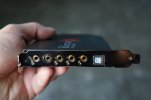I recently bought a Sound BlasterX AE-5 Plus internal sound card. I had a dual boot system, because I didn't know how well this would work with Linux. It turns out that it works great. At least with 6.6.9 kernel. Possibly older kernels as well. This a great upgrade to my on-board sound chip. There is a noticeable difference in sound quality. This works with pipewire, alsamixer, audacity, and easyeffects.
I really have a difficult time finding out much about SoundBlaster cards with Linux. Sometimes you have to do the testing yourself.
But in case anyone is wondering. This card works great with Linux.
I really have a difficult time finding out much about SoundBlaster cards with Linux. Sometimes you have to do the testing yourself.
But in case anyone is wondering. This card works great with Linux.


